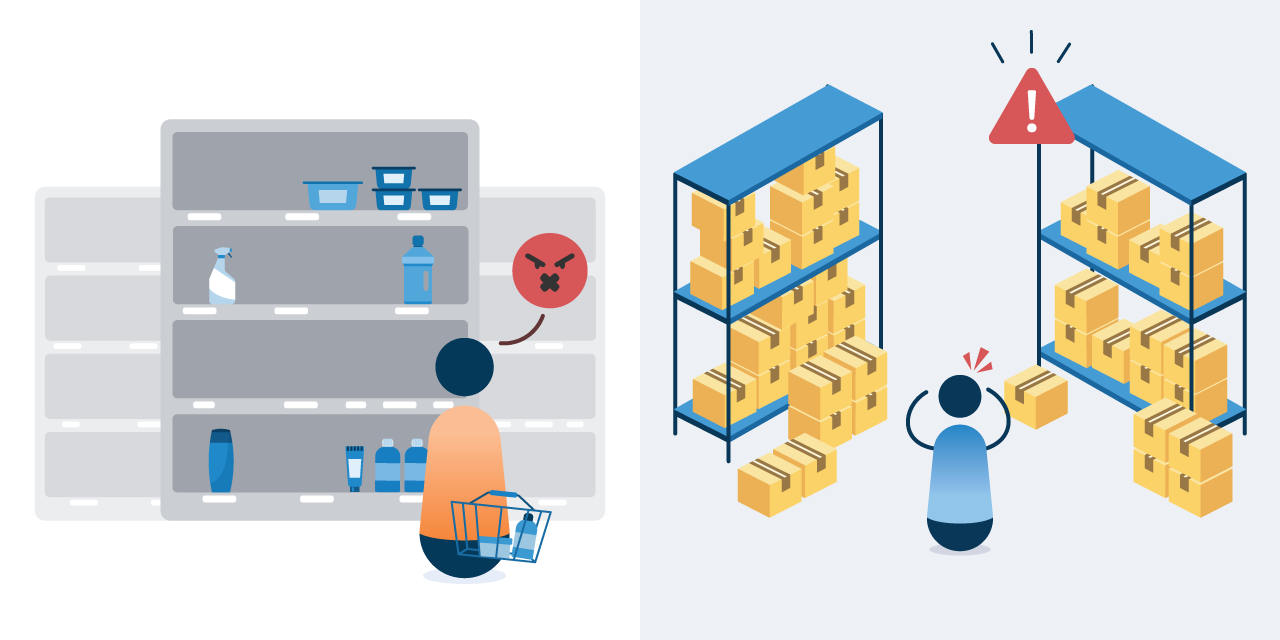On-shelf availability: The supply chain metric that belongs in the boardroom
Oct 9, 2025 • 6 min
If a product isn’t on the shelf, it can’t be sold. This simple truth makes on-shelf availability (OSA) the most honest measure of whether your supply chain actually works, yet most boardrooms treat OSA as an operational detail rather than the strategic metric it truly is.
You can have perfect forecast accuracy, flawless logistics, and brilliant marketing campaigns, but if shoppers can’t find your product when they want to buy it, you’ve failed. Manufacturers, consumer goods companies, and retailers feel this failure immediately in lost revenue and eroded margins. In the long term, poor OSA also destroys customer trust and tarnishes brand reputation.
The strategic payoff of OSA
Treating OSA as a board-level metric changes how organizations operate. When executives focus on availability, several things happen simultaneously:
- Sales increase as products are actually available to customers when demand spikes.
- Working capital improves as companies reduce their safety stock cushions, because they don’t need as much buffer when they get availability right.
- Inventory turns faster, which means fewer markdowns eating into profitability.
But the biggest shift happens in supplier-retailer relationships: When both sides prioritize the same metric, collaboration replaces finger-pointing. Trade negotiations become discussions about mutual success rather than zero-sum battles over margins. RELEX customers consistently report that OSA improvements translate into measurable gains in margins and operational efficiency.

Value drivers of OSA
The financial impact of OSA splits into revenue and cost components, and both matter to the board. Understanding these distinct value drivers helps to move beyond treating stockouts as isolated incidents and recognize availability as a systemic business challenge.
Revenue-side drivers
Every stockout represents immediate lost sales. Some shoppers wait for the product they want, but most buy a competitor’s product or shop elsewhere. During promotions, this problem multiplies. A retailer might negotiate a 30% discount and prominent shelf placement, only to run out of stock on the second day of a week-long campaign. The promotional investment is wasted, and the expected sales bump never materializes.
Consistent availability also builds trust, which is harder to measure but equally valuable. Shoppers return to stores where they can reliably find what they need, and brands that are always available become the default choices. This dependability builds loyalty that compounds over time into sustained market share advantages.
Cost-side drivers
Poor OSA triggers a cascade of unnecessary costs. Retailers penalize suppliers for failing to meet availability targets, and both sides resort to expensive expedited shipments to recover from stockouts. Safety stocks balloon as each party tries to buffer against the other’s unpredictability.
Waste increases too. When supply chain alignment breaks down, some products sit too long and expire, while others run out. The markdown spiral begins, cutting prices to move excess inventory that resulted from poor availability planning elsewhere in the network. These costs rarely appear as a single line item, which is why boards often miss their cumulative impact.
Specialized AI for improved OSA
The solution for better OSA requires genuine transparency and alignment between trading partners. The RELEX unified planning platform addresses this by creating shared visibility across organizational boundaries.
The platform starts by establishing a single source of truth for demand. Instead of retailers and suppliers maintaining separate forecasts, RELEX aggregates point-of-sale data, promotional calendars, and market intelligence into a unified demand signal both parties can trust. This shared forecast becomes the foundation for all downstream planning decisions.
Constraint visibility comes next. Suppliers expose their production capacity, lead times, and material availability while retailers share their distribution center capacity, store-level constraints, and promotional schedules. The platform reconciles these constraints automatically, flagging conflicts before they become crises.
With scenario planning, teams can model how different promotional timings affect supplier capacity, like whether everyday low prices or deep discounts drive better OSA outcomes. These scenarios use real constraints and validated demand patterns, not theoretical models.
The technical capabilities that enable this collaboration are sophisticated but accessible. Demand sensing incorporates point-of-sale data, weather patterns, and local events to improve short-term forecast accuracy. Meanwhile, machine learning algorithms identify phantom inventory (products that systems show as available but aren’t actually on shelves). Exception-based workflows focus human attention on the SKU-location combinations at risk of stockout.
These capabilities matter because they scale. A retailer with 50,000 SKUs across 500 stores can’t manually coordinate availability for millions of SKU-location combinations. But AI can monitor all of them continuously, flagging issues while there’s still time to intervene.

Fig. 2: The RELEX platform uses machine learning to monitor millions of SKU-location combinations and flag availability risks before stockouts occur.
How Atria Finland improved availability with RELEX
The disconnect between supplier production and retailer demand creates a familiar cycle of waste and stockouts in fresh food supply chains. Atria Finland, a leader in Nordic meat production, broke this cycle by replacing manual pre-orders and guesswork with automated forecast sharing through the RELEX platform.
Before implementing retail data integration, Atria Finland relied on a pre-ordering system that demanded hours of manual work from retail partners, like Minimani, each week. Despite this effort, uncertainty around actual demand forced Atria Finland to maintain expensive buffer stock. The company faced a classic supply chain dilemma: produce too early and risk spoilage, or produce too late and miss sales. Both options hurt OSA and eroded margins.
The transformation started when Atria began automatically receiving RELEX forecasts from Minimani in 2022, creating genuine operational alignment. Atria gained visibility into promotional plans, store-level demand patterns, and inventory positions across Minimani’s network. Instead of producing based on historical averages and hoping for the best, Atria could see demand changes and adjust production accordingly.
This visibility enabled a critical shift in production timing. With confidence in demand signals, Atria could delay production until closer to promotional campaigns, delivering fresher products with a longer shelf life to stores. The exception-based dashboard flagged potential availability issues while there was still time to intervene, focusing human attention on the SKUs and locations that actually needed it rather than drowning teams in data.
The results validated the approach. Minimani saw promotion availability for Atria products increase by three percentage points, a substantial improvement in a category where freshness windows are measured in days, not weeks. Manual pre-orders disappeared entirely, saving hours of work each week while improving availability outcomes. Campaign execution also improved as both parties worked from the same demand forecast rather than reconciling different versions after problems emerged.
OSA deserves a seat at the table
Boards track dozens of metrics, but most of these metrics measure internal efficiency rather than market success. OSA is different, it directly connects operational execution to customer experience and financial performance.
Making OSA a boardroom priority requires three commitments:
- Recognize that availability is a shared responsibility requiring genuine collaboration between retailers and suppliers. Neither side can solve it alone.
- Invest in platforms that enable this collaboration at scale. Spreadsheets and quarterly business reviews aren’t enough.
- Align incentives around availability rather than just cost reduction or margin improvement.
The companies that make these commitments will discover that OSA improvement drives broader transformation. Sales teams become more confident in their forecasts, supply chain teams reduce their buffer stock, finance sees working capital improve, and most importantly, customers find what they want when they want it.
On-shelf availability isn’t just another supply chain metric. It’s the proof point that your strategy works. The question for boards isn’t whether to prioritize OSA, but whether they can afford not to.
Ready to tackle the root causes of poor OSA? Phantom inventory and inaccurate stock records undermine even the best availability strategies. Learn how AI-driven inventory accuracy can eliminate the $400 billion problem hiding in your supply chain.




